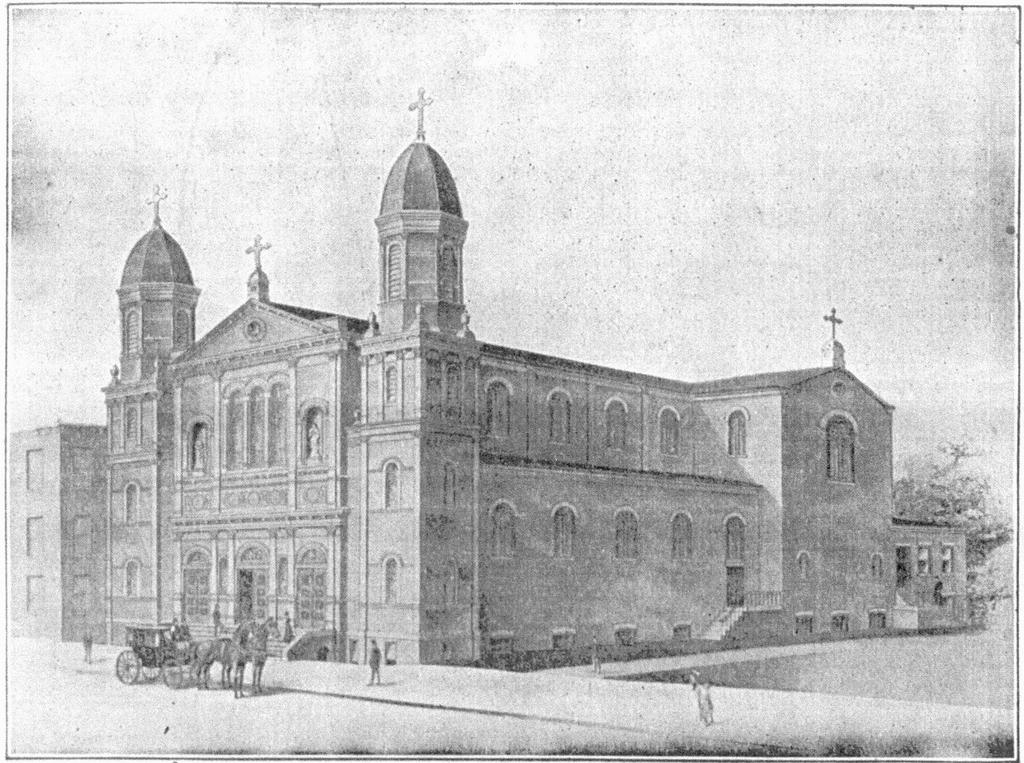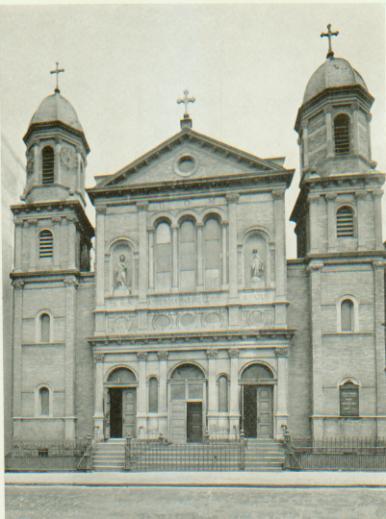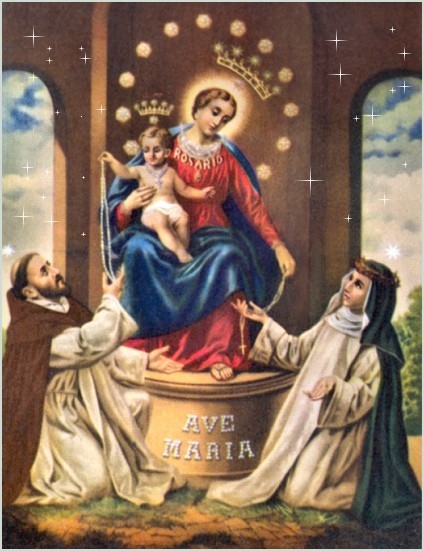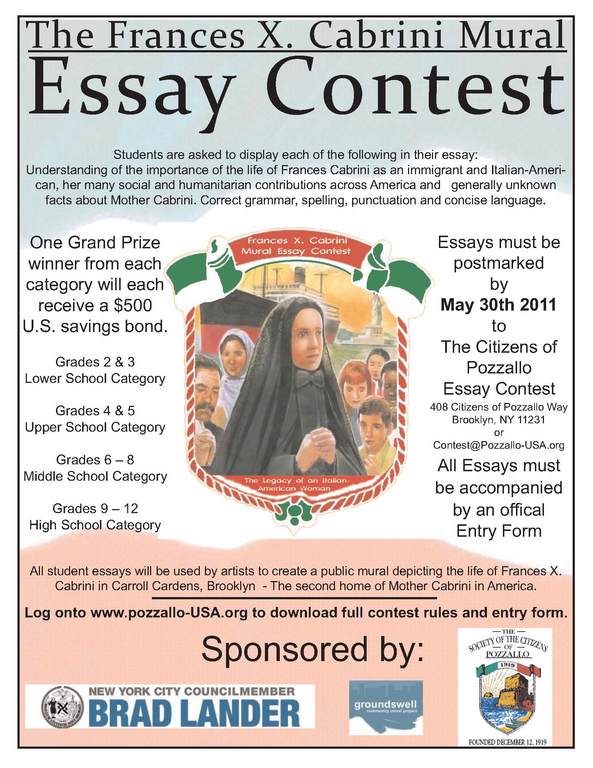Archives
You are currently viewing archive for March 2011
|
March 31, 2011 07:46:45
Posted By DelvecchioRC
|
Since its establishment as Brooklyn's First Italian Parish, Sacred Hearts of Jesus and Mary Parish has had Four homes. This is the Third Home, located at Hicks and DeGraw Streets and built in 1907.

The front is built of gray brick with trimmings of lime stone. The rest of the church is built of red brick. The church has a tower on each corner with belfreys for bells. In the centre part of the building, over the main entrances are two niches containing the statues of the Sacred Hearts of Jesus and Mary donated by the contractors.

|
|
March 31, 2011 07:36:48
Posted By DelvecchioRC
|
Excerpt Taken from Souvenir Journal from the dedication of the
Church of Sacred Hearts of Jesus and Mary, 1907.
…Our new church reminds us therefore of the real old Basilica style, and although I never saw one built in this country, there is no doubt that for its beauty and architectural lines and practical use as a church, there will come a time when more churches of this the oldest style of architecture will be built. Our church is 60 feet 6 inches wide and 68 feet 6 inches across the transept and is 140 feet long. The basement is 12 feet high and contains a large auditorium, capable of seating 1000 people, store room and boiler room in the rear. In front is a large vestibule. The basement has three front, two side and one rear exit. The whole basement is well-finished with plumbing and electrical work, etc. Entering the church by its large front stoop, you enter a vestibule by three doors. The vestibule runs the full width of the church, with stairs in each tower to the choir. Entering from the vestibule into the church, you will see that the church is clear story structure. The walls of the clear story are supported by ten columns. The lower side walls are provided with corbles for statues and stations of the Cross. The lower ceilings are 25 feet high. The main ceiling 45 feet high. The ceilings are level and are paneled and have a heavy cornice.
The sanctuary and side chapels have arched ceilings. In the sanctuary are two windows, one representing the Last Supper, which is donated in memory of Mariano Savarese; the other representing Pentecost, and is a gift in memory of Vincenzo Savarese. There are three niches for the statues of the Sacred Hearts of Jesus and Mary and St. Joseph. The side chapels have a niche over the altar, to receive the statue of The Immaculate Conception, donated by the General of the Pious Society of Missions, and the statue of St. Michael. In the transept on one side is a window representing the Resurrection , both donated by the Right Reverend Monsignor P.J. O’Hare. On either side of each window are large paintings representing Christ in agony in Gethsemani, The Assumption, The Purification is donated by A. Castruccio and Sons and the Ascension by Mr. Joseph Vitelli. There is a large painting on the ceiling of the transept representing the Sacred Heart s of Jesus and Mary surrounded by angels, which is a gift from Salvatore Savarese fu’ Vincenzo. On one side of the transept is an altar for a calvary group, and on the other side one for St. Anthony, which statue was donated by Mrs. Zito. The Baptistry is located on the right side, entering the Church and the marble Baptismal font is a gift of Mrs. Caterina Podesta. The choir is pretty pacious and can seat about 150 people, independent of giving room for the choir.
|
|
March 30, 2011 06:20:27
Posted By DelvecchioRC
|
The traditional story of the rosary was that Mary herself appeared to Saint Dominic in the twelfth century. At that time, tradition says she gave him the rosary and promised Dominic that if he spread devotion to the rosary, his religious order would flourish. It is quite true that Dominic was quite devoted to the Blessed Mother, but no one knows for sure if Our Lady herself gave Dominic the rosary. If she did, it is quite certain that she did not give him a rosary that looks like the one we have today.
Originally the rosary had 150 beads, the same number of psalms in the Bible. In the twelfth century, religious orders recited together the 150 Psalms as a way to mark the hours of the day and the days of the week. Those people who didn’t know how to read wanted to share in this practice, so praying on a string of 150 beads or knots began as a parallel to praying the psalms. It was a way that the illiterate could remember the Lord and his mother throughout the day. The “Divine Office”; the official prayer of the church; is the recitation of the psalms over a four week period, and is still prayed today.
This first rosary was prayed as we do today, a person would pass their fingers over each bead and say a prayer, usually the “Our Father”. The “Hail Mary” as we know it wasn’t even around at that time.
The Hail Mary owes its origin to the rosary. When people said the rosary in the twelfth century, Gabrielle’s greeting “Hail Mary, full or grace, the Lord is with thee” was often said along with the Our Father. Later, Elizabeth’s greeting ”blessed are you among women” was added. It was not until the sixteenth century that the words “Holy Mary., Mother of God, pray for us sinners now and at the hour of our death” were added.
Various people have added other things to the rosary over the centuries. In the fifteenth century, a Carthusian monk divided the rosary into fifteen brackets (or decades) and a Dominican assigned mysteries to each of the decades. These mysteries were events in the life of Jesus as written in the gospels. By meditating on these events even the illiterate could know the stories in the Bible. These decades were the same as ours except for the last two Glorious mysteries. In those two, the Coronation and the Assumption together made up the fourteenth decade and the fifteenth decade was the Last Judgment.
On October 16, 2002, Pope John Paul II, declared that the following year would be the “Year of the Rosary”. For the first time in centuries a change was made in the rosary. The Pope added and defined 5 new mysteries that concerned events in the public life of Jesus. These new mysteries were called the “Luminous Mysteries” or “Mysteries of Light”
Today’s complete rosary is now made up of twenty decades of the Hail Mary, separated by an Our Father and a Glory Be and sometimes the Fatima prayer. Evidence again that the rosary is a living prayer that grows with the church. We usually break the rosary into four sets. The four sets are The Joyful Mysteries, The Sorrowful Mysteries, The Glorious Mysteries, and the Luminous Mysteries. One set is prayed on a rosary that has five decades. Each set is prayed on designated days of the week. There are variations however, and in some countries the rosary may even have different mysteries.
Despite all the additions and changes, the important core of the rosary has always remained the same. It is a way for God’s people to make holy the day, and to remember the life of Jesus and his mother.

|
|
March 29, 2011 10:14:22
Posted By DelvecchioRC
|
This Thursday, March 31st at 7:30pm in the Rectory Hall
Guest Speaker: Fr. Claudio Antecini, Koinonia John the Baptist
Fr. Claudio is the superior of the Koinonia Community based in the parish of The Visitation of th Blessed Virgin Mary in Red Hook. Fr. Claudio explains his own faith journey, "I was born in Italy. At age 20 I met the founder of the spiritual movement of Koinonia, Fr. Ricardo in Camparmo. There I felt this is my home. I left everything to follow Jesus who called me. I was the fifth brother to be called to this community at its very beginning. I lived with no water, no electricity, no telephone, in material poverty - but extraordinary spiritual wealth."
The community
Koinonia John the Baptist
The Koinonia John the Baptist is a Catholic community of consecrated members who live together in poverty, chastity and obedience. They give their lives to the Lord in the spirit of John the Baptist, praying and evangelizing for the salvation of souls. Their global mission is three-fold:
•To inspire the faithful to evangelize, bringing others into the church
•To minister using the charisms and powers of the Holy Spirit
•To create faith-filled Christian communities throughout the world.
The word “koinonia” is the Greek word used in the original gospel to describe the first Christian community.
The Koinonia John the Baptist was born in 1979 when a catholic priest Fr. Ricardo Argañaraz, together with a small nucleus of two brothers and one sister, answered the Lord’s call to leave everything and to follow Him. They ascended to a small mountainous area in Vicenza (Italy), called Camparmò. They began to live a consecrated life, dedicated to prayer, listening to the Word of God, work and study. In the solitude of the beginnings a strong experience of prayer, listening to the Word of God, fraternal love and of the Father’s providence in the details of their everyday life became deeply rooted in them. During the years the Koinonia John the Baptist spread out from Camparmò into Europe and to many other countries such as Africa, South America, the United States of America and India. After many years of friendship with believers in Israel, the Koinonia John the Baptist became aware of the need for unity among Christians. For this reason the community is present for some years now in Jerusalem, where the members are part of the Hebrew-speaking Catholic community.
|
|
March 28, 2011 06:39:30
Posted By DelvecchioRC
|
Years before Catholic leaders could erect church buildings for the Italian community, the Church recognized a need to find ways to serve these Italian Catholics who would otherwise have found themselves religiously lost at sea in their new land. That imperative led Pope Leo the XIII, in 1880, to ask a young nun, Maria Francesca Cabrini, to go to America to help with the care of the many new immigrants. Through her remarkable work in New York and elsewhere in America she would become known throughout the world simply as Mother Cabrini, one of the most renowned Catholic lives to unfold in the New World.
Joined by seven other members of her newly-formed religious order, the Missionary Sisters of the Sacred Hearts of Jesus, Mother Cabrinimade the journey from Italy and arrived in New York City in 1189. She and the sisters immediately began working to help the poor Italians they found on the streets of Manhattan. Mother Cabrini soon needed more support for her work and sought assistance from the Archbishopo of New York, Michael Augustine Corrigan, who was an Irish Catholic.Archbishop Corrigan did not support Mother Cabrini's efforts at first and instead told her to go to Brooklyn. Mother Cabrini thereby came to work at the parish of Sacred Hearts of Jesus and Mary. Recognizing a need to educate the Italian immigrant children, Mother Cabriniand her sisters established a school in the parish in 1892, which was placed under the direction of her order. Brooklyn's Bishop McDonnell bought a former church building to be used as the school on Van Brunt and President Streets from the Moravian church. It was named the St. Charles School. During her life, Mother Cabrini would go on to found sixty-seven schools, hospitals, orphanages, and missions, one for every year in her life.
Mother Cabrini was beatified in 1938 and made history as the first American Citizen canonized a saint by the Catholic Church, when she was named Saint Frances Xavier Cabrini in 1946. She was also given the title of the patron saint of immigrants.
Mother Cabrini's influence countinues to this day; many older parishioners of Sacred Hearts- St. Stephen parish still recount stories of their parents' and grandparents' personal encounters with this legend of Italian- American Catholicism.
Currently the Society of the Citizens of Pozzallo are holding an essay contest on Mother Cabrini. Students from 2nd Grade though High School have been asked to write an essay on Cabini and her life. These essays will be used to create a public mural of Mother Cabrini, which is to be erected on the wall of the Summit Street walk Bridge on Hicks Street. for more information contact the Pozzallo club at www.pozzallo-usa.com 
|
|
|
|

